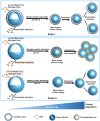Impact of particle size and pH on protein corona formation of solid lipid nanoparticles: A proof-of-concept study
- PMID: 33996415
- PMCID: PMC8105779
- DOI: 10.1016/j.apsb.2020.10.023
Impact of particle size and pH on protein corona formation of solid lipid nanoparticles: A proof-of-concept study
Abstract
When nanoparticles were introduced into the biological media, the protein corona would be formed, which endowed the nanoparticles with new bio-identities. Thus, controlling protein corona formation is critical to in vivo therapeutic effect. Controlling the particle size is the most feasible method during design, and the influence of media pH which varies with disease condition is quite important. The impact of particle size and pH on bovine serum albumin (BSA) corona formation of solid lipid nanoparticles (SLNs) was studied here. The BSA corona formation of SLNs with increasing particle size (120-480 nm) in pH 6.0 and 7.4 was investigated. Multiple techniques were employed for visualization study, conformational structure study and mechanism study, etc. "BSA corona-caused aggregation" of SLN2‒3 was revealed in pH 6.0 while the dispersed state of SLNs was maintained in pH 7.4, which significantly affected the secondary structure of BSA and cell uptake of SLNs. The main interaction was driven by van der Waals force plus hydrogen bonding in pH 7.4, while by electrostatic attraction in pH 6.0, and size-dependent adsorption was confirmed. This study provides a systematic insight to the understanding of protein corona formation of SLNs.
Keywords: BSA corona-Caused aggregation; Cell uptake; Conformational structure; Medium pH; Nanoparticle-protein interaction; Protein corona; Size effect; Solid lipid nanoparticles.
© 2021 Chinese Pharmaceutical Association and Institute of Materia Medica, Chinese Academy of Medical Sciences. Production and hosting by Elsevier B.V.
Conflict of interest statement
The authors have no conflicts of interest to declare.
Figures











Similar articles
-
Interaction of solid lipid nanoparticles with bovine serum albumin: physicochemical mechanistic insights.Phys Chem Chem Phys. 2025 Mar 12;27(11):5876-5888. doi: 10.1039/d4cp04737k. Phys Chem Chem Phys. 2025. PMID: 40028927
-
Adsorption of Myoglobin and Corona Formation on Silica Nanoparticles.Langmuir. 2020 Dec 1;36(47):14157-14165. doi: 10.1021/acs.langmuir.0c01613. Epub 2020 Nov 19. Langmuir. 2020. PMID: 33210541 Free PMC article.
-
Modulation of serum albumin protein corona for exploring cellular behaviors of fattigation-platform nanoparticles.Colloids Surf B Biointerfaces. 2018 Oct 1;170:179-186. doi: 10.1016/j.colsurfb.2018.05.060. Epub 2018 May 28. Colloids Surf B Biointerfaces. 2018. PMID: 29906703
-
A health concern regarding the protein corona, aggregation and disaggregation.Biochim Biophys Acta Gen Subj. 2019 May;1863(5):971-991. doi: 10.1016/j.bbagen.2019.02.012. Epub 2019 Feb 22. Biochim Biophys Acta Gen Subj. 2019. PMID: 30802594 Free PMC article. Review.
-
Protein corona, understanding the nanoparticle-protein interactions and future perspectives: A critical review.Int J Biol Macromol. 2021 Feb 1;169:290-301. doi: 10.1016/j.ijbiomac.2020.12.108. Epub 2020 Dec 21. Int J Biol Macromol. 2021. PMID: 33340622 Review.
Cited by
-
Nanoparticle-Based Drug Delivery Systems Enhance Treatment of Cognitive Defects.Int J Nanomedicine. 2024 Nov 6;19:11357-11378. doi: 10.2147/IJN.S484838. eCollection 2024. Int J Nanomedicine. 2024. PMID: 39524925 Free PMC article. Review.
-
Comparative Studies of the Uptake and Internalization Pathways of Different Lipid Nano-Systems Intended for Brain Delivery.Pharmaceutics. 2023 Aug 3;15(8):2082. doi: 10.3390/pharmaceutics15082082. Pharmaceutics. 2023. PMID: 37631296 Free PMC article.
-
Potential of Alpha-Mangostin-Loaded PLGA Nanoparticles for Cholangiocarcinoma Treatment.Polymers (Basel). 2022 Oct 20;14(20):4444. doi: 10.3390/polym14204444. Polymers (Basel). 2022. PMID: 36298022 Free PMC article.
-
Surface antibody changes protein corona both in human and mouse serum but not final opsonization and elimination of targeted polymeric nanoparticles.J Nanobiotechnology. 2023 Oct 14;21(1):376. doi: 10.1186/s12951-023-02134-4. J Nanobiotechnology. 2023. PMID: 37838659 Free PMC article.
-
Nano-Formulations for Pulmonary Delivery: Past, Present, and Future Perspectives.Pharmaceutics. 2024 Jan 24;16(2):161. doi: 10.3390/pharmaceutics16020161. Pharmaceutics. 2024. PMID: 38399222 Free PMC article. Review.
References
-
- Stefanick J.F., Omstead D.T., Kiziltepe T., Bilgicer B. Dual-receptor targeted strategy in nanoparticle design achieves tumor cell selectivity through cooperativity. Nanoscale. 2019;11:4414–4427. - PubMed
-
- Wang Y.B., Wu W.B., Liu J.J., Manghnani P.N., Hu F., Ma D., et al. Cancer-cell-activated photodynamic therapy assisted by Cu(II)-based metal-organic framework. ACS Nano. 2019;13:6879–6890. - PubMed
-
- Wan S.S., Cheng Q., Zeng X., Zhang X.Z. A Mn(III)-sealed metal-organic framework nanosystem for redox-unlocked tumor theranostics. ACS Nano. 2019;13:6561–6571. - PubMed
-
- Rezaei G., Mojtaba Daghighi S., Raoufi M., Esfandyari-Manesh M., Rahimifard M., Iranpur Mobarakeh V., et al. Synthetic and biological identities of polymeric nanoparticles influencing the cellular delivery: an immunological link. J Colloid Interface Sci. 2019;556:476–491. - PubMed
-
- Sousa F., Dhaliwal H.K., Gattacceca F., Sarmento B., Amiji M.M. Enhanced anti-angiogenic effects of bevacizumab in glioblastoma treatment upon intranasal administration in polymeric nanoparticles. J Control Release. 2019;309:37–47. - PubMed
LinkOut - more resources
Full Text Sources

